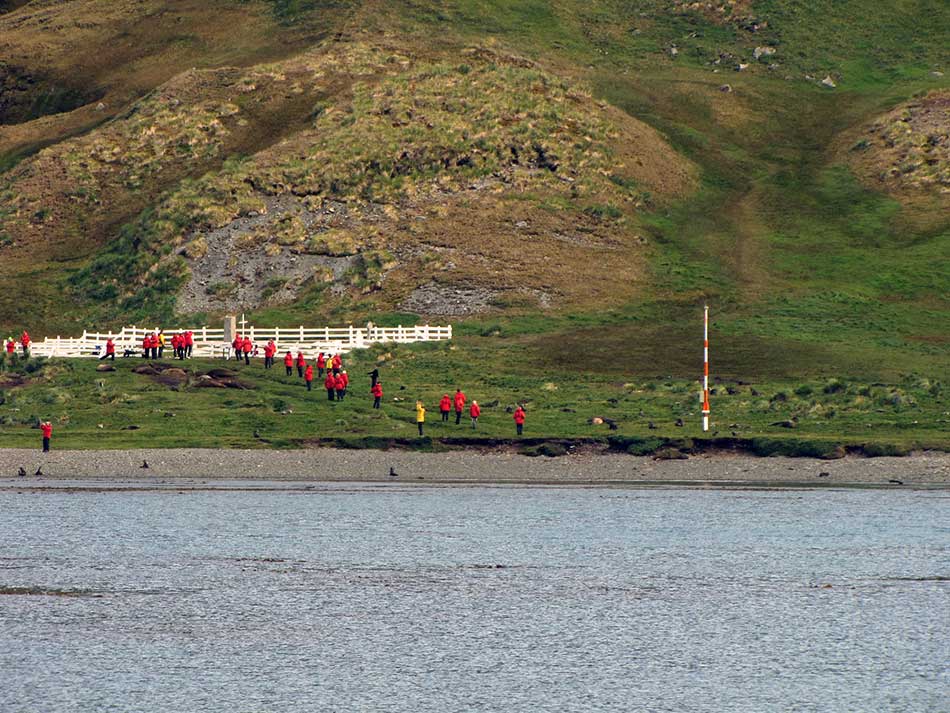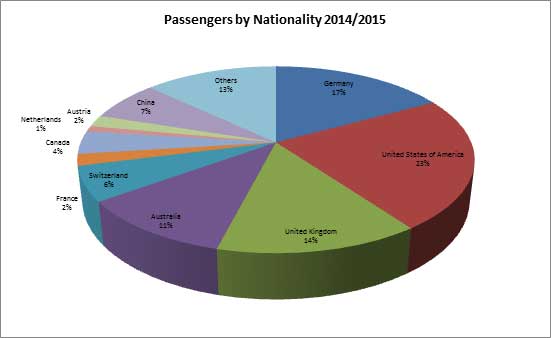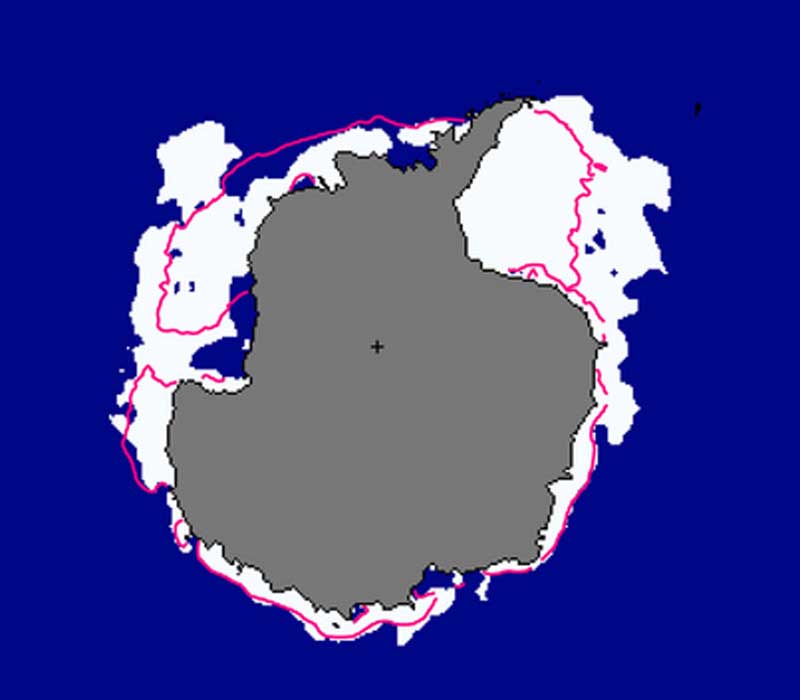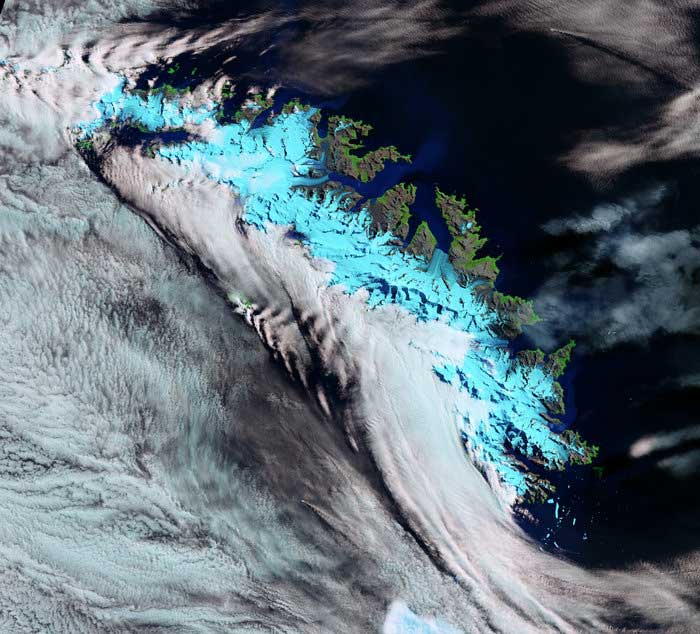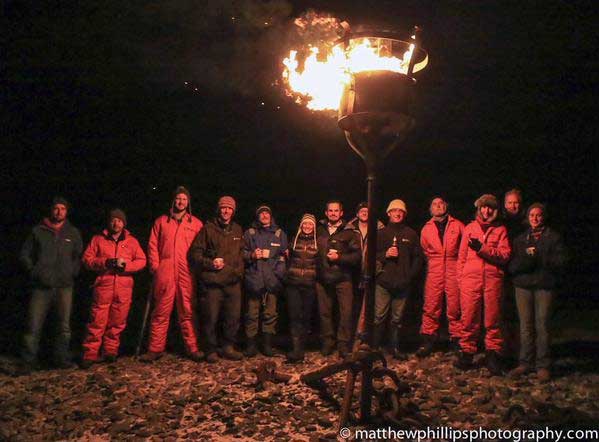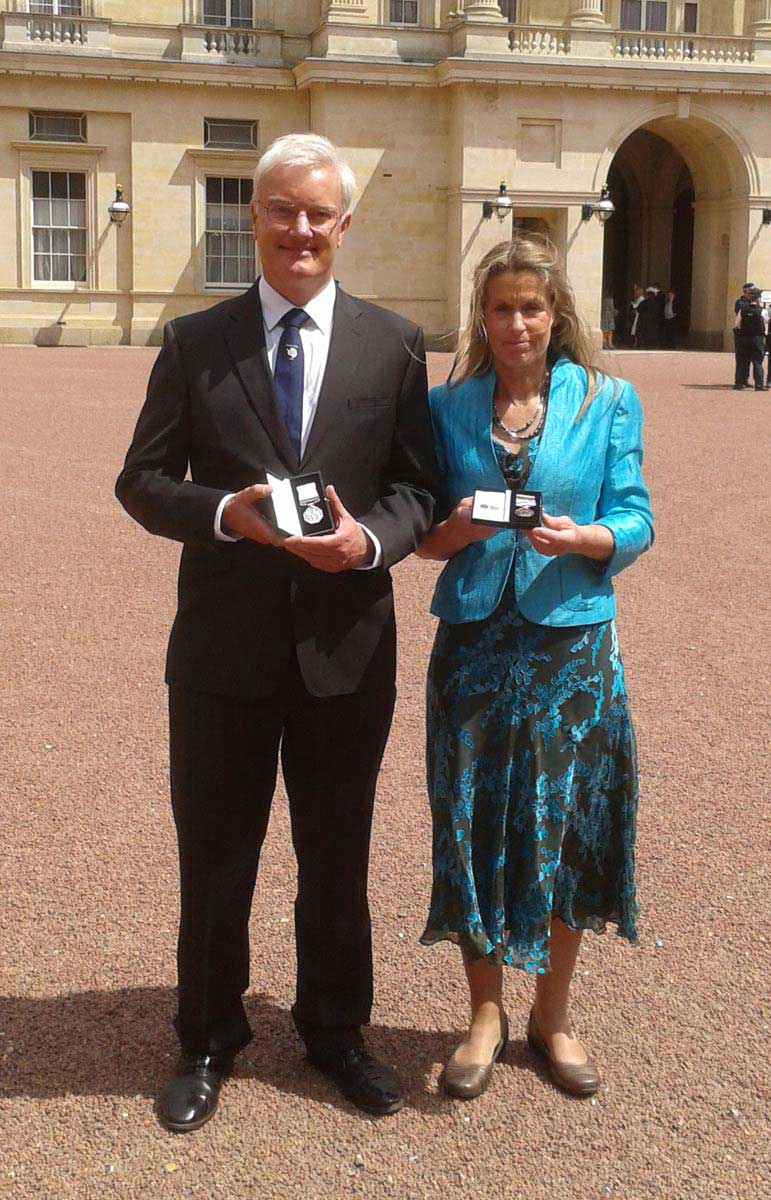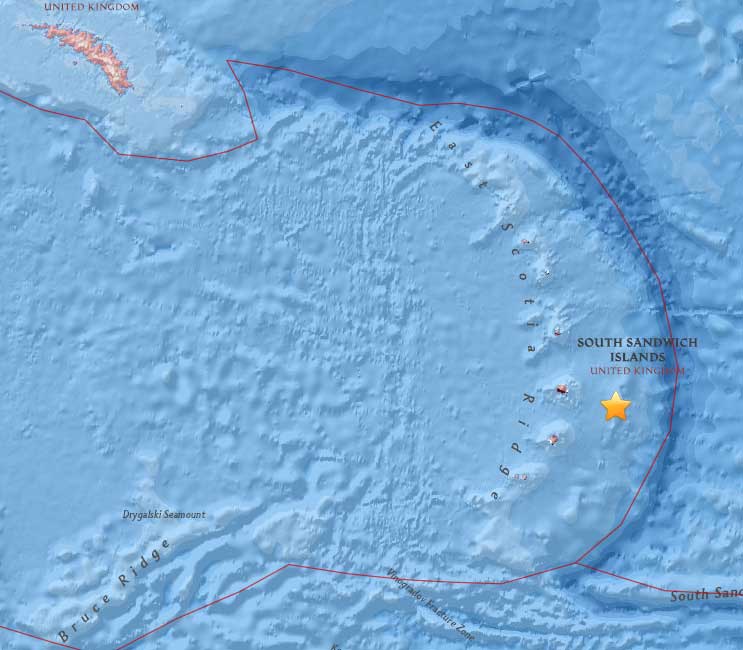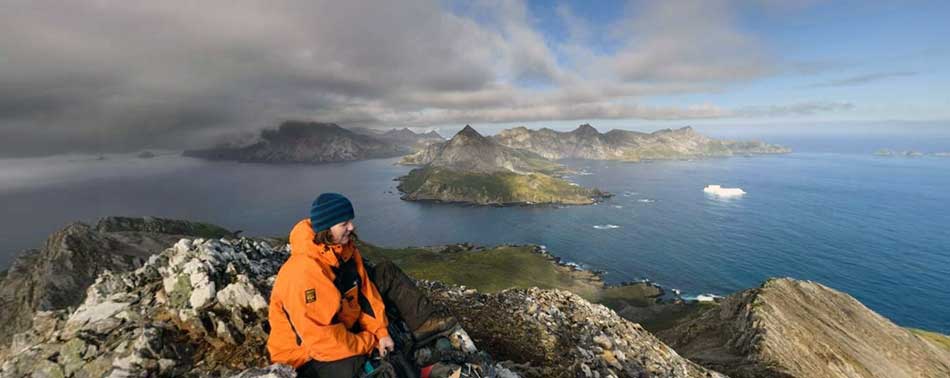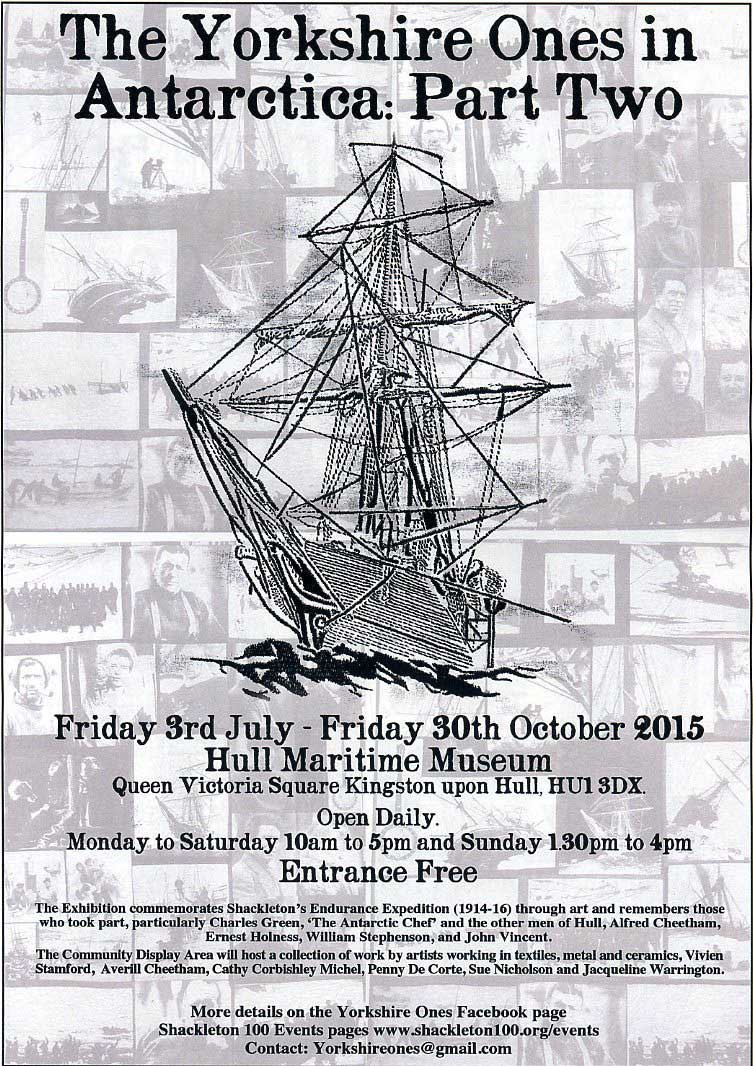This newsletter is not produced by GSGSSI; it does not necessarily reflect their views.
To subscribe to the SGIsland News Alerts list click here
South Georgia attracted the highest ever number of cruise ship passengers in the 2014/15 season, in contrast to falling numbers of tourists visiting the Antarctic. A total of 8,142 cruise ship passengers visited South Georgia last season, slightly more than the previous highest number which was 8,068 in the 2007/8 season. After that the visitor numbers fell back sharply, mainly due to a global financial depression, and have been steadily climbing again since. Last season’s cruise passenger total was 15% higher than the season before. Meanwhile in the Antarctic the International Association of Antarctic Tour Operators (IAATO) reported that last season 2% fewer tourists (36,702) visited Antarctica (with IAATO members) than in the season before.
There were 65 cruise ship visits to South Georgia in the 2014/15 season, which is the highest number since 2009/10. There were more ship visits (70) in the 2008/9 season but they only brought 7,700 passengers. This reflects a change in the cruise industry as a number of smaller cruise ships have now left the industry and been replaced by vessels that typically carry 100-150 passengers.
Tourists visiting South Georgia came from sixty-seven different nations last season. The largest number (23%) came from the USA, with the UK (14%), Germany (17%) and Australia (11%) making up other larger percentages. The number of Chinese visitors nearly doubled (7%) compared to the previous season.
Cruise ship expedition staff came from 35 different nations, the largest number from the USA and cruise ship crew came from 66 different nations but half of them were from the Philippines.
Analysis of where the cruise ships visited showed that, after Grytviken, the site most often visited was Gold Harbour. There were 49 cruise ship visits to this stunning bay, which has a large king penguin colony with an impressive scenic backdrop of mountains and hanging glaciers. It is also home to several other species of penguins, seabirds and seals. Almost as popular was the vast king penguin colony at Salisbury Plain with 47 visits.
There were two new vessels in the 2014/15 season – National Geographic Orion and Le Soleal.
Sixteen yachts made 21 visits to South Georgia in the 2014/15 season.
In December 2014, GSGSSI undertook a round island census of black browed and grey-headed albatross. Because colonies are usually located on steep coastal headlands and seacliffs it is not possible to access them from the land so the fisheries patrol vessel Pharos SG supported a two person team, (Sarah Browning and Georgina Strange) to photograph the colonies from the water.
The survey team battled wind, snow and some extremely rough seas to access the exposed headlands with most of the work taking place from the Pharos SG’s RIB. Boat suits and a good pair of gloves were essential as the girls often spent many hours a day in the open boat working to get all the shots needed for the survey.
At the end of the 14-day trip, more than 1,000 photos had been taken including close up shots and perspectives at 12 locations around South Georgia. Next came the massive job of stitching together the photos and counting the birds. This task was taken on by experienced seabird ecologist, Kieran Lawton.
After the total number of birds in each colony was counted, the number of breeding pairs were corrected for diurnal variation and for nest failure between the date of laying and the date each colony was censuses. Data for the correction factors was gathered by British Antarctic Survey Scientist, Jess Walkup, who is based on Bird Island.
 Simon Hunter Down, a Royal Marine who was one of the first to climb to the highest peak on South Georgia, died in January.
Simon Hunter Down, a Royal Marine who was one of the first to climb to the highest peak on South Georgia, died in January.
Simon joined the Royal Marines in 1957 and after officer training was selected for flying training, qualifying to pilot Whirlwind Helicopters in 1960. He served in 848 Squadron aboard HMS Bulwark in the Far East and in 1962 joined 846 Squadron for operations in Sarawak during the Indonesian confrontation.
Simon was an enthusiastic climber and was often to be found in his spare time on limestone cliffs dotted around the jungles of Borneo and Malaya, close to wherever he was based. He was immensely strong and displayed a level of determination that was the envy of many of his friends. In 1964 he joined Malcolm Burley’s Combined Services Expedition to South Georgia which repeated, for the first time, Shackleton’s epic traverse of the Island from King Haakon Bay to Stromness.
The expedition also conducted surveys of some of the coastal areas. But the most important feature of this expedition was the first ascent of Mt Paget East Peak, 2935m. West Paget had been climbed for the first time by Captain Vivian Stevenson RM, Lt Commander Malcolm Burley and Corporal Rev Todd RM on 13 December 1960 but the East, and higher peak, had eluded the efforts of this team launched by helicopter to the shore from HMS Protector off the West coast. Simon and his team, Sgt Tom Lynch of the Parachute Regiment and Senior Aircraftsman John Chester of the RAF, made the first ascent of the East Peak from sea level in Fortuna Bay and reached the summit on December 30th 1964. The expedition was commemorated by the issue of four stamps, one of which depicted two of the team on the summit of Mt Paget East Peak.
On return from South Georgia Simon continued to fly Wessex helicopters based at the RN Air Station at Culdrose in Cornwall. He married, had two children and now began to devote most of his spare time to riding, hunting, and equestrian events at point to points and the Royal Tournament. In the mid 1970s Simon was diagnosed with multiple sclerosis and so his career in the Royal Marines was most cruelly ended when he was invalided from the service in early 1980.
Simon was a great companion, a natural Leader, big hearted, generous, with an indomitable spirit. He died on January 7th 2015 in Wiltshire where he had lived with his son Jason and his family.
Compiled by Colonel Guy Sheridan
Scientists at Bird Island have witnessed mid-air attacks on fledgling black-browed albatross. Newly fledged black-brows have been seen being harried and killed by skuas and giant petrels when the albatross were on their maiden flights. Writing in the ACAP newsletter, albatross zoological field assistant Lucy Quinn describes watching an attack happen.
“The first flight of one black-browed albatross fledgling was ungainly and, unfortunately, was to be its last. It was not flying particularly strongly, flapping rapidly just to stay airborne, but was at least heading out to sea. However, within 10 seconds of take-off two sub-Antarctic skuas appeared (based on their degree of coordination they were likely a pair), and took it in turns to harass the fledgling and peck at its back. They were quickly joined in flight by three Northern giant petrels. Apparently trying to escape, the fledgling turned back towards land. As the skuas continued to harass the albatross from above, one of the giant petrels came from below to seize its tail, eventually downing the bird. The giant petrels landed, followed closely by the skuas. In total, the entire predation event took less than six minutes from the time the chick left its nest. The giant petrels then killed and consumed the fledgling.”
Another fledgling was seen being harried in flight later the same day. This behaviour has not been reported before at Bird Island. The scientists are now wondering how many albatross chicks are killed in this way shortly after fledging.
Read the original story on the ACAP website here.
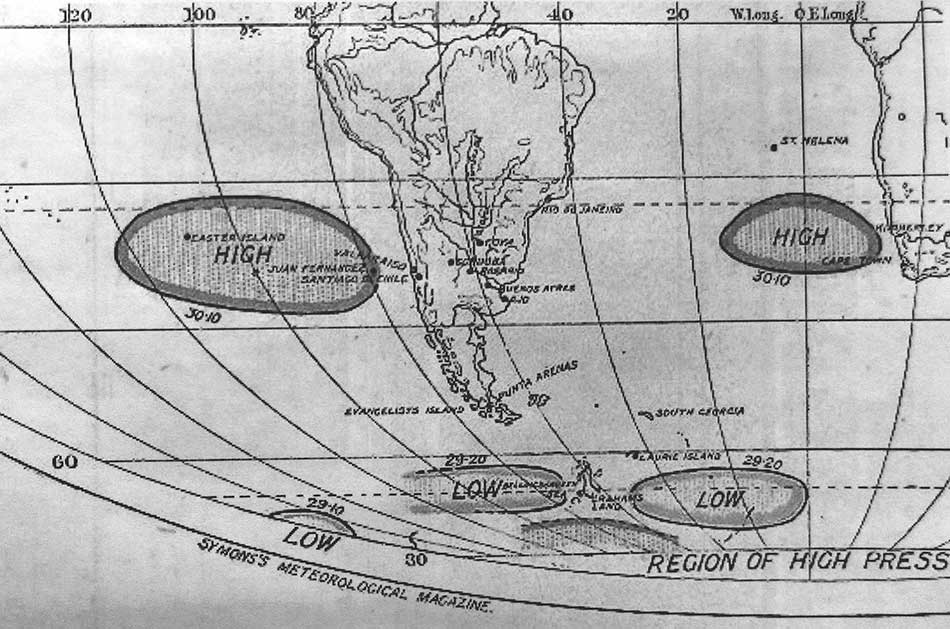
Robert Mossman’s chart showing the correlating pattern of high and low pressure systems he identified in what is now known as El Nino.
A study of the causes of the heavy sea ice conditions in the Antarctic when Shackleton’s Endurance Expedition was heading south is published just as the same phenomena is causing record sea ice levels in the area today.
The paper’s authors debunk the myth that it was the whalers at South Georgia that warned Shackleton of if being ‘a bad ice year’ in the Weddell Sea. Shackleton actually knew the ice was likely to be an obstacle because the effects of what is now known as ‘El Nino’ were beginning to be understood by meteorologist Robert Mossman. Mossman was interested in links between weather and ice in the Antarctic and weather in South America. He realised that rainfall in South America could be an indicator of ice extent further south, and vice versa. Mossman’s theory was recognised when, whilst Endurance was in Buenos Aires, the expedition geologist James Wordie wrote in his diary: ‘…it looks as if the pack would be very heavy this season; this is following Mossman’s theory of heavy rains in the Argentine in Spring (just what we are having) being due to the ice in the Weddell Sea not having broken out early’.
Despite Shackleton’s expedition waiting a month at South Georgia because of the ice threat, their shipEndurance was still trapped in the ice and ultimately sunk.
El Nino is defined as an anomalous, yet periodic, warming of the central and eastern equatorial Pacific Ocean. It occurs every 2-7 years for a period of 6-18 months.
One hundred years later record breaking sea ice is being recorded in Antarctica, and once again the large ice extent is associated with an El Nino event. Sea ice levels are nearly 45% higher than the 1981-2010 average. This is 220,000 square miles more than the previous sea ice record set in 2008. Vessels trying to reach science bases in the Antarctic have been struggling to get through the ice to deliver vital stores. The greater extent of sea ice also affected tourist ships trying to visit the continent last summer, preventing some of them from reaching their regular landing sites. The current El Nino is expected to persist and may be one of the strongest ones in two decades according to U.S. and Australian government meteorologists.
Why does El Nino affect the Antarctic sea ice? During El Nino years the waters of the Eastern Pacific heat up and warm the air which rises and starts to move toward the South Pole. The effect of the earth’s rotation is to turn the winds eastward where it strengthens the subtropical jet stream. This stronger jet stream diverts storms away from the Pacific side of the South Pole so there is less wind to blow sea ice farther out into the ocean, so the ice stays close to shore.
The paper ‘Robert Mossman, Endurance and the Weddell Sea ice’ by Robert Burton and John C King can be downloaded from the Cambridge Journals here.
See more about the current effects of El Nino here.
White-chinned petrel fledglings are being tracked thanks to funding raised from South Georgia fisheries’ licence fees. South Georgia is home to more than half the world’s population of white-chins. The birds inhabit burrows, mainly in tussac grass slopes. Young white-chins have not been tracked before, so scientists fitted satellite tags to birds on Bird Island in early April, before they fledged, and are now mapping where the birds go as they search for food. The distances covered in the first few weeks after fledging are in excess of 9000 kilometres.
White-chinned petrels, which can live for 30 years, are the most common bird recorded as fisheries bycatch in the Southern Ocean. At Bird Island there was a decrease of 28% in nesting burrow occupancy between the 1970s and 1990s. Although measures have been taken to reduce the risks, they are still regularly killed in longline and trawl fisheries and are listed as Vulnerable on the IUCN Red List of Threatened Species. The scientists think the greatest risk to the birds is on the Patagonian shelf, which is where most of the tagged birds seemed to be heading and where there is intensive fishing.
The tracking of the young white-chins is part of a wider tagging programme to track non-breeding movements and at-sea activity patterns of older birds at South Georgia and in the Falkland Islands.

Scruffy looking grey-headed albatross chick.
As winter moves on the temperature continues to drop; the streams have been frozen, meaning we’ve had to don the crampons to make it up the hill or across the beaches when we are out doing field work. The black-browed albatross chicks have all gone now, but the grey-headed chicks are beginning to look very elegant in their feathers, although some still have tufts of fluff poking out here and there.
We’ve been treated to hoards of gentoo penguins coming ashore onto Fresh Water Beach, right in front of base. They are incredibly inquisitive creatures, and even braved coming close to one of their predators, Max the leopard seal, for a closer look while he was sleeping on the beach. I also came across a chinstrap on Main Bay last week, who looked quite lost, wandering the beach on his own.
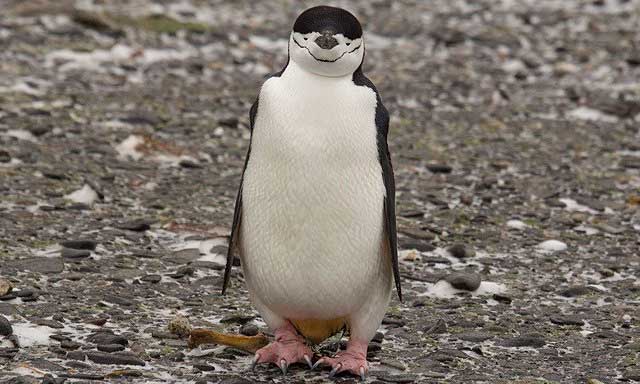
Chinstrap penguin “looking lost” on Main Bay.
The leopard seals continue to arrive and I’ve been lucky enough to see a few kills. Max was spotted in the bay chewing on a fur seal really close to shore, thrashing it from side to side, the cape petrels swooping in to grab whatever morsels they could. Stephanie put on less of a spectacle, but a more impressive kill last week, when I spotted her eating a small elephant seal. It was shame to see one getting eaten; they’re such placid beasts when they’re hauled out on the beaches here. It was especially sad as there was a similar sized elephant seal sitting on the rocks, watching Stephanie eat its conspecific.
SG from Space: A stunning image of the northern coast of South Georgia seen from space forms the basis of a two minute video on the European Space Agency Web TV video ‘Earth from Space’. Presented by Kelsea Brennan-Wessels, the video zooms in on mountains and glaciers on a colourful image that was taken from space on February 16th 2015. The southern coast is obscured by cloud but there is clear atmosphere over the south-eastern tip and you can see the massive icebergs that have accumulated there in recent months.
Click here to see the video.
SGA Initiative Fund Open to All: The South Georgia Association (SGA) will welcome applications for its Initiative Fund. Grants of up to £500 are available for those undertaking projects to do with South Georgia. The fund will be opened to non-members of the SGA. Find out how to apply here.
SGA Shackleton Legacy Papers On Line: An archive of the papers presented at the ‘Shackleton Legacy’ meeting, a combined initiative by the SGA and Friends of the Scott Polar Research Institute (SPRI) held on November 8th 2014, can now be read on line on the SGA website.
The conference’s aim was to discover more about the achievements of Shackleton and his men and the subsequent development in leadership skills, Antarctic science and expedition techniques. The meeting was a great success with over 100 people attending. Summaries of many of the talks can now be read here.
SG Lights Up for VE Day: A beacon was lit on the beach at KEP on May 8th, VE Day. The beacon was one of hundreds lit to commemorate the 70th anniversary of the end of the second world war in Europe. At least 100 similar beacons were lit throughout the United Kingdom – a chain of light with the first lit at sunset.
Comments Please: A reminder that you are invited to read and comment on the GSGSSI ‘Draft South Georgia and the South Sandwich Islands Strategy for the next five years’. Details here.
Polar Medals at the Palace: Sally Poncet and Patrick Lurcock collected their Polar Medals on May 21st at Buckingham Palace. The investiture was made by Prince William, Duke of Cambridge. Both Sally and Pat have a long association with South Georgia. Sally first visited in 1977, going on to conduct numerous biological and historical field surveys and assist with recent habitat restoration work. Patrick has been working at KEP since 1992.
The Polar Medal is awarded by the Sovereign to UK citizens for conspicuous contributions to the knowledge of polar regions or rendering prolonged service of outstanding quality in support of acquisition of such knowledge. The first polar medals were awarded in 1904 to members of Scott’s Discovery Expedition.
Earthquake in South Sandwich Islands: An earthquake measuring 5.3 magnitude occurred 84km ENE of Bristol Island, in the South Sandwich Islands, on May 26th. The moderate earthquake originated at a depth of 32km at 58.648°S 25.208°W.
Grytviken in Hull: The well-known aquarium, The Deep, in Hull has a display that will look familiar to those who have visited South Georgia. The backdrop to their gentoo penguin display in the ‘Kingdom of Ice’ exhibition is a recreation of Grytviken whaling station!
The exhibition aims to educate visitors about global warming, ocean acidification and food chains.
Grytviken was selected as the backdrop because of the way the abandoned whaling stations at South Georgia have been recolonised by the island’s wildlife. The gentoo enclosure at The Deep runs over three floors and includes a swimming pool, diving pool, beach area, nesting area and an outdoor balcony giving the penguins a view overlooking the River Humber. It cost £750,000 to create and gives visitors the chance to watch the gentoo penguins both underwater and on land.
The penguins in the enclosure were born and raised in captivity in Texas, at Moody Gardens and are now part of a European breeding programme.
The Deep helps conservation projects through their ‘Project Penguin’ initiative which raises money for research work in the wild to help protect endangered penguins. http://www.thedeep.co.uk
Panoramas and Courting Wanderers: Keen photographer Alastair Wilson is helping bring Bird Island vividly to life for armchair travellers. He has recently added two new 360-degree panoramas to Google Maps. Alastair, who is a Zoological Field Assistant and Winter Station Leader at Bird Island, said: “Working for BAS has given me the chance to take photos in places many people only ever dream of, and I wanted to share what I could see – all of it. I started creating 360-degree panoramas four years ago while working at King Edward Point, using my SLR and a DIY panoramic tripod head. Now I am at Bird Island, a place where very few people get the chance to visit, so what better way to show people this beautiful island. Luckily there are few people to spot me doing what looks like a strange ritual around my tripod, taking photographs at every angle from the variety of peaks and viewpoints.”
Visit the world’s second largest Macaroni Penguin colony ‘Big Mac’ or Bird Island’s highest peak, La Roche, via Google Maps or by using the links below. Alastair said: “Though you can share the beautiful view, you might be relieved that you don’t yet have to experience the same smells over the internet!”
Big Mac: http://bit.ly/1DjLcvZ
La Roche summit: http://bit.ly/1HYvdeT
Alastair has also shared this lovely short clip of courting behaviour of wandering albatrosses – here
A hundred years ago Shackleton’s Endurance Expedition was underway and so many of the events highlighted in this section relate to Shackleton Centenary events. Shackleton had strong links to South Georgia and is buried at Grytviken.
The Yorkshire Ones in Antarctica: An exhibition to commemorate Shackleton’s Endurance Expedition through art and to commemorate the Hull locals involved in the expedition. The artists, whose works include textiles, ceramics and metal works, are also mainly local. The exhibition opens on July 3rd and runs until the end of October at the Hull Maritime Museum.
Penguin City Weekend: The South Georgia Association is organising a weekend event in Edinburgh, Scotland, which is open to everyone to attend. Edinburgh has many links to South Georgia and to Sir Ernest Shackleton. The two-day meeting will be centred on Edinburgh Zoo which is famous for its penguins. The first penguins at the zoo were collected in South Georgia by whalers.
The weekend starts on Friday evening with a Scottish dinner, and a Shackleton whisky presentation and tasting led by the renowned whisky expert Richard Paterson. On Saturday there will be 11 short presentations and a “behind the scenes” tour of the zoo’s Penguin Rock facility. The weekend will conclude with a dinner at Channings Hotel, part of which was once home to Sir Ernest and Emily Shackleton.
The weekend costs £65, including all the above. Accommodation has to be booked separately.
The Penguin City Weekend on Friday 30th and Saturday 31st October 2015 is expected to be popular and numbers are limited so apply early. Email here.
South Georgia Mapping Presentation: A talk about South Georgia mapping forms part of the “Maps & Surveys 2015” event at the Defence Surveyors Association Annual Seminar on June 27th. The talk by Adrian Fox, Head of Mapping at BAS, will describe the evolution of mapping of South Georgia, from the earliest mapping efforts, through the expeditions of Duncan Carse in the 1950s into the interior of the island, to modern maps at detailed scales produced from satellite imagery to support the recent rat and reindeer eradication projects.
More information about the Maps and Survey’s event here.


